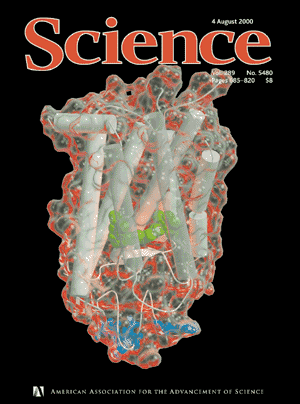Crystal structure of rhodopsin
問い合わせ番号
SOL-0000000916
ビームライン
BL45XU(生体高分子結晶解析 II)
学術利用キーワード
| A. 試料 | 生物・医学 |
|---|---|
| B. 試料詳細 | 結晶, 膜, 生体組織、細胞系等, 生体材料, 生体高分子、結晶, 蛋白質 |
| C. 手法 | X線回折 |
| D. 手法の詳細 | 単結晶構造解析 |
| E. 付加的測定条件 | 低温(〜液体窒素) |
| F. エネルギー領域 | X線(4~40 keV) |
| G. 目的・欲しい情報 | 分子構造, 構造解析, 結晶構造 |
産業利用キーワード
| 階層1 | 製薬 |
|---|---|
| 階層2 | ドラッグデザイン |
| 階層3 | タンパク質 |
| 階層4 | 局所構造, 絶対構造決定 |
| 階層5 | 回折 |
分類
A80.50 製薬, M10.10 単結晶回折
利用事例本文
Crystal structure of bovine rhodopsin was determined by multiwavelength anomalous diffraction (MAD) method at RIKEN Structural Biology Beamline I with a tricromatic concept optimizing to MAD method. Rhodopsin is activated by light and turn on the signaling pathway that leads to vision, and is a member of heterotrimeric guanine nucleotide-binding protein (G protein)-coupled receptors (GPCRs). The protein forms a bundle of seven transmembrane helices connected by six loops of varying lengths. The ground-state chromophore, 11-cis-retinal, holds the transmembrane region of the protein in the inactive conformation. The detailed structure gives insights into the mechanisms of receptor activation, and the source of specific ligand and G-protein interactions.
The crystal structure of the light-sensitive protein rhodopsin. Members of this family of seven-transmembrane helix G protein-coupled receptors detect environmental signals and transmit them to cells. The protein backbone is shown schematically with a transparent surface. The pigment that absorbs light, 11-cis-retinal (a derivative of vitamin A), is shown in green, and the carbohydrate moiety is blue. (Cover illustration of Science 289 (2000))
[ K. Palczewski, T. Kumasaka, T. Hori, C. A. Behnke, H. Motoshima, B. A. Fox, I. L.Trong, D. C. Teller, T. Okada, R. E. Stenkamp, M. Yamamoto and Miyano, Science 289, 739-745 (2000), Fig. front page,
©2000 American Association for the Advancement of Science ]
画像ファイルの出典
原著論文/解説記事
誌名
Sience, 289, (2000)
図番号
front page
測定手法
画像ファイルの出典
図なし
測定準備に必要なおおよその時間
24 時間
測定装置
参考文献
| 文献名 |
|---|
| K.Palczewski, T.Kumasaka, T. Hori, C.A.Behnke, H.Motoshima, B.A.Fox, I.L.Trong, D.C.Teller, T.Okada, R.E.Stenkamp, M.Yamamoto, M.Miyano, Science, 289 (2000), 739-745. |
関連する手法
アンケート
SPring-8だからできた測定。他の施設では不可能もしくは難しい
本ビームラインの主力装置を使っている
同種実験は本ビームラインの課題の30%以上を占めている
測定の難易度
中程度
データ解析の難易度
熟練が必要
図に示した全てのデータを取るのにかかったシフト数
4~9シフト

